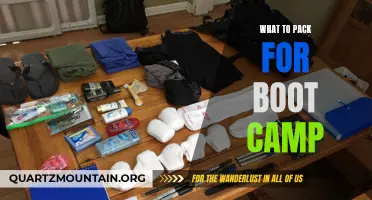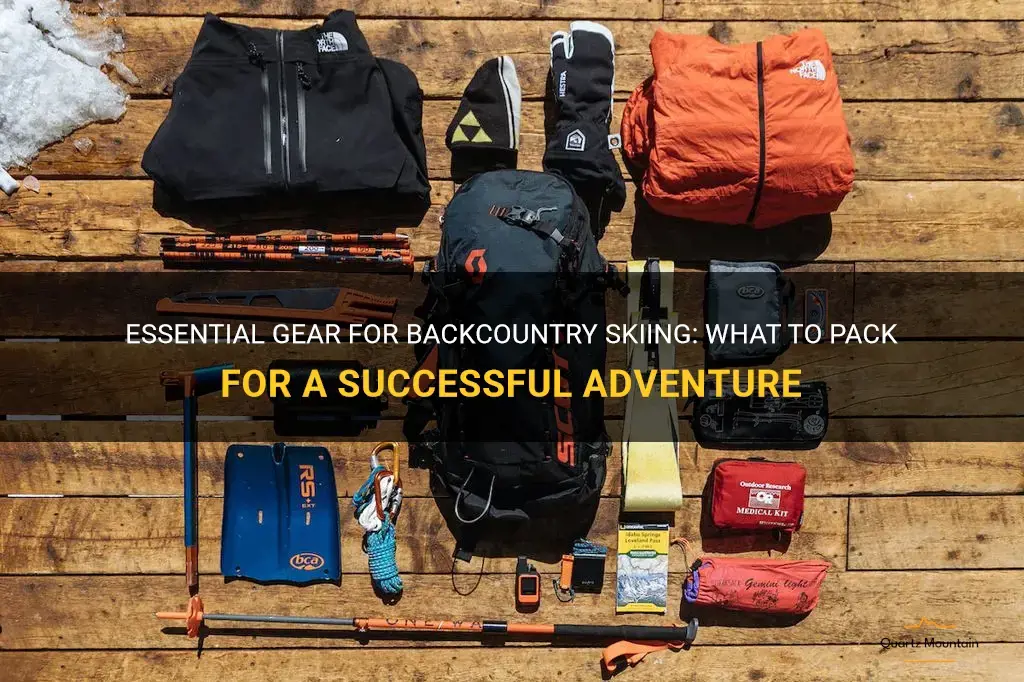
Backcountry skiing is a thrilling and challenging activity that allows you to explore untouched wilderness areas and enjoy the peaceful solitude of the mountains. However, venturing into the backcountry requires careful preparation and the right gear to ensure a safe and successful adventure. From avalanche safety equipment to essential survival tools, this guide will highlight the must-have gear that every backcountry skier should pack before heading out into the snowy wilderness. So, whether you're a seasoned pro or a beginner looking to embark on your first backcountry skiing trip, read on to discover the essential gear that will help you have an unforgettable experience.
| Characteristics | Values |
|---|---|
| Skis | Alpine touring or Telemark skis |
| Bindings | Tech or frame bindings |
| Boots | Alpine touring or Telemark boots |
| Skins | Nylon or mohair skins |
| Poles | Adjustable ski poles |
| Backpack | 20-35 liters backpack |
| Beacon | Digital avalanche beacon |
| Shovel | Collapsible aluminum shovel |
| Probe | 2.4-3 meter probe |
| Helmet | Certified ski helmet |
| Goggles | UV protection goggles |
| Layering Clothing | Base layers, insulating layers, and waterproof shell |
| Gloves/Mittens | Waterproof and insulated gloves/mittens |
| Hat/Beanie | Insulated hat or beanie |
| Thermos | Insulated thermos for hot drinks |
| Extra Food and Water | High-energy snacks and water |
| First Aid Kit | Basic first aid supplies |
| Map and Compass | Navigation tools |
| Headlamp | Compact and lightweight headlamp |
| Sunscreen | High SPF sunscreen |
| Emergency Shelter | Lightweight emergency shelter or bivy sack |
| Extra Batteries | For electronic devices |
| Repair Kit | Ski repair tools and spare parts |
| Communication Device | Cell phone or two-way radio |
| Sunglasses | UV protection sunglasses |
| Knife | Multitool or pocket knife |
| Fire Starter | Waterproof matches or lighter |
What You'll Learn
- What are the essential items to pack for a backcountry skiing trip?
- Are there any specific safety gear or equipment that is necessary for backcountry skiing?
- Are there any specific clothing or accessories that are recommended for backcountry skiing?
- How much food and water should be packed for a backcountry skiing trip?
- Are there any additional items that are helpful to bring but not essential for backcountry skiing?

What are the essential items to pack for a backcountry skiing trip?
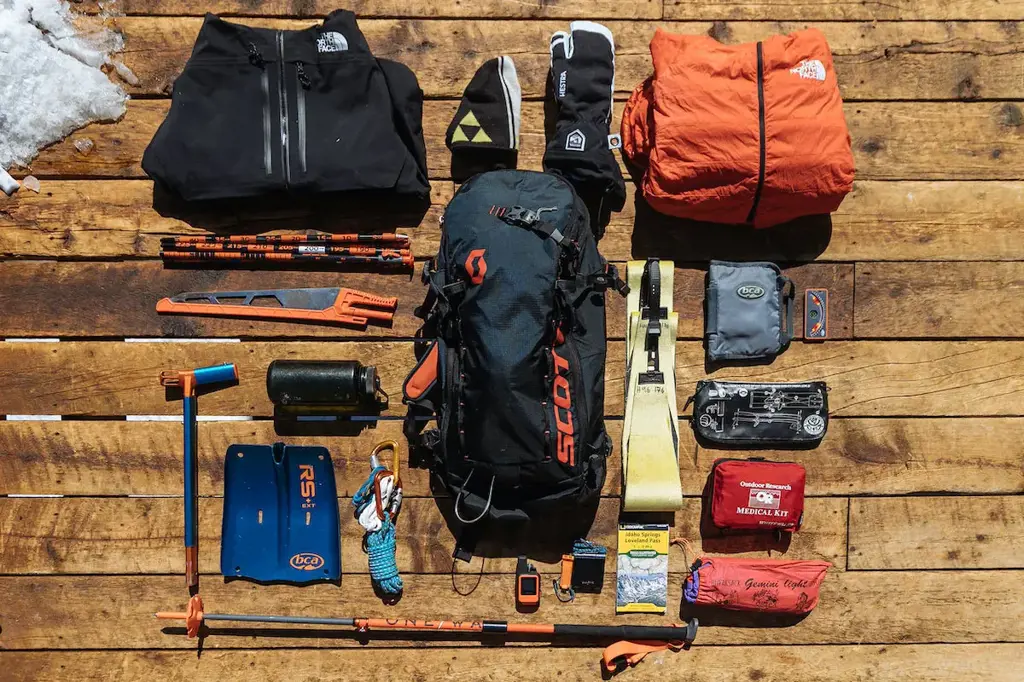
Backcountry skiing is an exhilarating and challenging adventure that allows avid skiers to explore untouched snow-covered landscapes. However, it also requires careful planning and preparation to ensure a safe and enjoyable experience. One crucial aspect of preparing for a backcountry skiing trip is packing the right gear and equipment. In this article, we will discuss the essential items you need to pack for a backcountry skiing trip.
Skis and Boots:
Choosing the right skis and boots is essential for backcountry skiing. Opt for a pair of lightweight and versatile skis that provide stability and maneuverability. Look for ski boots that are specifically designed for backcountry skiing, as they offer better flexibility and range of motion.
Rescue Gear:
Safety should be your top priority when embarking on a backcountry skiing trip. Pack essential rescue gear, which includes an avalanche beacon, probe, and shovel. These items will help you locate and dig out anyone caught in an avalanche.
Safety Equipment:
In addition to rescue gear, it is crucial to pack safety equipment such as a helmet, goggles, and appropriate clothing layers. A helmet protects your head from injuries, while goggles shield your eyes from blinding snow and harsh winds. Layered clothing is essential for regulating body temperature, as backcountry skiing conditions can change rapidly.
Backpack:
A sturdy and functional backpack is essential for carrying all your gear. Look for a backpack specifically designed for backcountry skiing, as it will have compartments and features to accommodate your equipment, water, and food. Ensure your backpack is lightweight and comfortable, as it will be on your back throughout the entire trip.
Navigation Tools:
To navigate through the backcountry ski routes, you will need reliable navigation tools. A GPS device, compass, and maps of the area are essential for route planning and ensuring you stay on track. Familiarize yourself with the terrain and landmarks beforehand, and always carry a compass as a backup in case your GPS fails.
Food and Water:
Backcountry skiing requires a lot of physical exertion, so it is crucial to pack enough food and water to keep yourself energized and hydrated. Energy bars, nuts, dried fruits, and sandwiches are excellent options for lightweight and nutritious snacks. Carry a water bottle or hydration bladder and ensure that you have access to clean water sources along your route.
First Aid Kit:
Accidents can happen anywhere, and being prepared with a first aid kit is essential. Pack a well-equipped first aid kit that includes bandages, antiseptic ointment, pain relievers, blister treatment, and any other necessary medications. Additionally, make sure you are familiar with basic first aid procedures to provide immediate care in case of an emergency.
Communication Devices:
In case of an unforeseen event or emergency, it is essential to have communication devices to call for help. Carry a fully charged cell phone, a two-way radio, or a satellite phone. It's also worth considering an emergency beacon, which can send a distress signal and notify emergency services of your location.
Repair Tools:
Backcountry skiing can be rough on your equipment, so it is wise to carry essential repair tools. Include a multi-tool, duct tape, extra ski straps, and a repair kit for your bindings and poles. These tools will come in handy if you encounter any equipment malfunctions or failures during your trip.
Emergency Shelter:
In extreme situations, you may need to spend an unexpected night in the backcountry. Carrying a lightweight emergency shelter, such as a bivy sack or emergency blanket, provides protection from the elements and helps retain body heat.
Remember, backcountry skiing requires proper training and knowledge of avalanche safety. Before embarking on a backcountry skiing trip, ensure that you have the necessary skills and experience. It is also advisable to ski with a group and inform someone about your plans and expected return time. With the right gear and preparation, backcountry skiing can be an unforgettable and rewarding experience in the great outdoors.
Essential Items to Pack for a Relaxing Vacation at a Mexico Resort
You may want to see also

Are there any specific safety gear or equipment that is necessary for backcountry skiing?
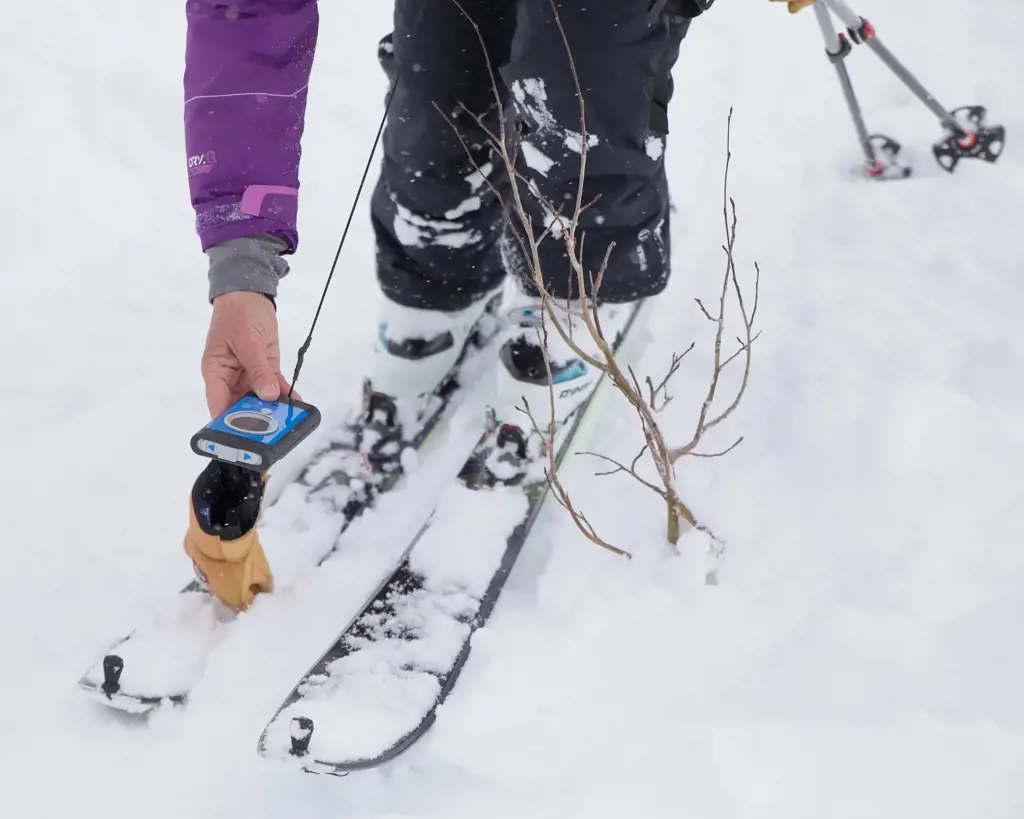
Backcountry skiing is a thrilling and exhilarating activity that allows skiers to explore untouched terrain and experience the beauty of nature. However, it also comes with its own set of risks. To ensure a safe and enjoyable experience, it is essential to have the right safety gear and equipment. In this article, we will discuss the specific gear and equipment that are necessary for backcountry skiing.
Avalanche Safety Gear:
Avalanches are a significant risk in backcountry skiing, and having the right avalanche safety gear is crucial. This includes an avalanche beacon, shovel, and probe. An avalanche beacon is a device that emits a signal that can be picked up by other beacons, enabling rescuers to locate someone buried in an avalanche. A shovel is used to dig out a buried person, and a probe is used to locate them under the snow.
Avalanche Airbag:
An avalanche airbag is an essential piece of equipment that can greatly increase your chances of survival in an avalanche. It is a backpack with an integrated airbag system that, when deployed, increases your volume and reduces your density, allowing you to stay on top of the snow. This not only helps to reduce burial depth but also improves your chances of being found quickly.
Climbing Skins:
Backcountry skiing often involves climbing uphill, and climbing skins are necessary to provide traction on the snow. These are adhesive strips that attach to the base of your skis, allowing you to grip the snow while ascending. They are designed to be easily attached and removed and are an essential piece of equipment for backcountry skiing.
Alpine Touring Bindings:
Alpine touring bindings are a type of ski binding that allows the heel to be free while ascending and locks it in place while descending. This provides greater mobility and flexibility while climbing and ensures stability and control while skiing downhill. It is important to choose bindings that are compatible with your boots and provide the necessary safety features.
Helmet:
Wearing a helmet is a must when backcountry skiing, as it provides protection against head injuries. Even though backcountry skiing is often done in remote areas and away from crowds, accidents can still happen. A helmet can significantly reduce the risk of serious head injuries in case of a fall or collision.
Avalanche Airbag Backpack:
In addition to the avalanche safety gear mentioned earlier, it is advisable to carry an avalanche airbag backpack. This is a backpack with an integrated airbag system that can be deployed in an avalanche. The airbag helps to keep you on the surface of the snow and increases your visibility, making you easier to locate and rescue.
It is important to note that safety gear and equipment is just one aspect of backcountry skiing safety. It is also crucial to have the necessary skills, knowledge, and experience to navigate avalanche terrain and make informed decisions. Taking avalanche safety courses, practicing rescue techniques, and staying updated on current avalanche conditions are all essential for backcountry skiers.
In conclusion, backcountry skiing requires specific safety gear and equipment to mitigate the risks associated with the activity. Avalanche safety gear, helmets, climbing skins, alpine touring bindings, and avalanche airbag backpacks are all necessary to ensure a safe and enjoyable experience. However, it is important to remember that safety gear is only a part of the equation, and skiers must also possess the necessary skills and knowledge to navigate avalanche terrain safely.
10 Delicious Lunch Ideas for Your Husband's Packed Meal
You may want to see also

Are there any specific clothing or accessories that are recommended for backcountry skiing?
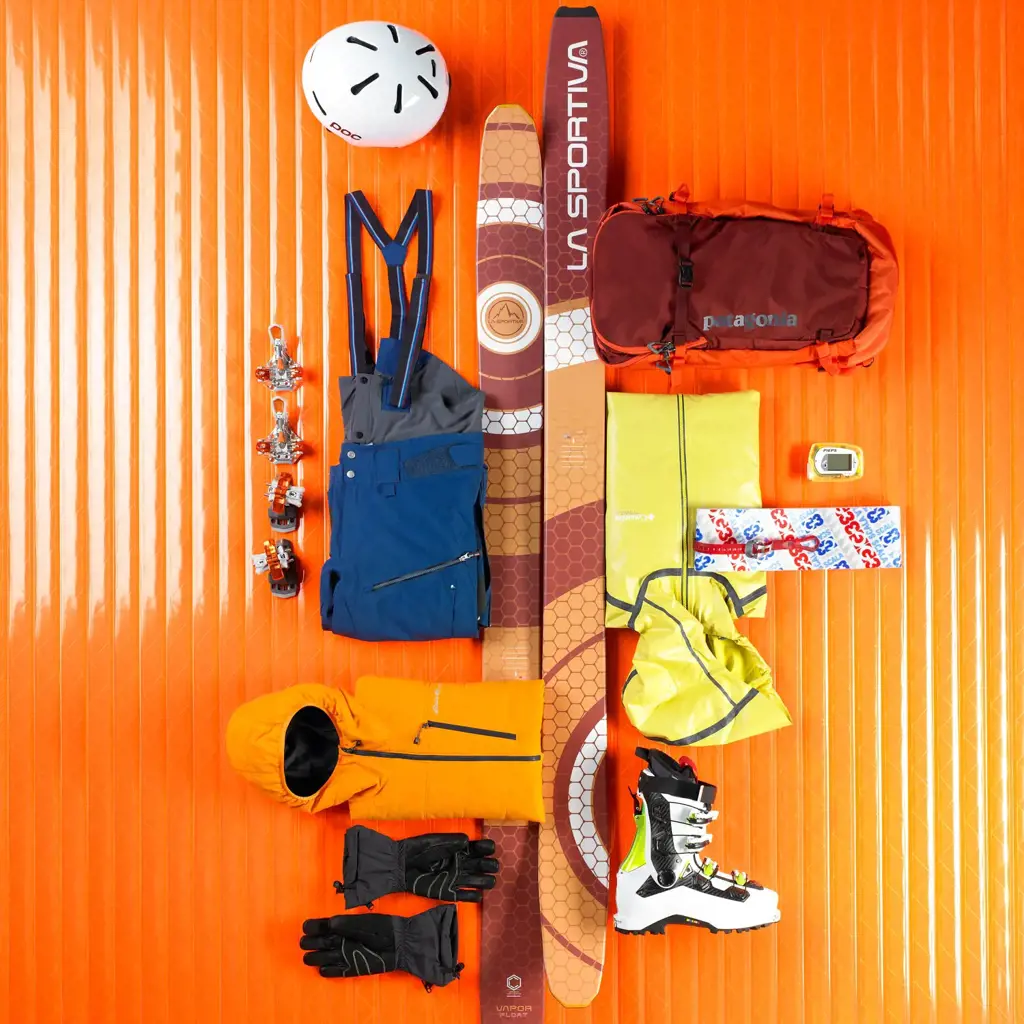
When it comes to backcountry skiing, having the right clothing and accessories can make all the difference in terms of comfort, safety, and performance. Backcountry skiing entails navigating rugged terrain and often involves challenging weather conditions, so it's important to be well-prepared with appropriate gear.
One of the key considerations when choosing clothing for backcountry skiing is layering. Layering allows you to regulate your body temperature and manage moisture effectively. The three-layer system is commonly used, comprising a base layer, an insulating layer, and an outer shell.
For the base layer, choose a moisture-wicking material such as merino wool or synthetic fabric. This layer should fit snugly against your skin and should be able to wick sweat away to keep you dry.
The insulating layer is responsible for retaining body heat. Fleece or down jackets are popular choices for backcountry skiers. Fleece is lightweight and breathable, while down provides excellent insulation. Consider the weather conditions and your personal preferences when selecting an insulating layer.
The outer shell layer, typically a waterproof and breathable jacket and pants, is essential for protection against wind, snow, and rain. Look for garments with a high waterproof rating and adequate ventilation options to prevent overheating. Additionally, make sure the jacket has a hood to shield your head from the elements.
In terms of accessories, a good pair of gloves is vital for maintaining dexterity and protecting your hands from the cold. Look for gloves that are waterproof, breathable, and insulated. It's also a good idea to carry an extra pair of gloves as a backup.
Protecting your head is crucial, and a helmet should always be worn while backcountry skiing. Look for a helmet that is specifically designed for skiing and has adjustable ventilation to regulate temperature. Additionally, wearing a thin beanie or hat underneath the helmet can provide added warmth.
Goggles or sunglasses are essential for eye protection. Choose lenses that provide adequate UV protection and consider tint options depending on the lighting conditions. Goggles are generally preferred in snowy or windy conditions, while sunglasses are suitable for clear and sunny days.
Additionally, make sure to wear appropriate socks that are moisture-wicking and provide cushioning and support. Good ski socks will help keep your feet dry and minimize the risk of blisters.
It's also important to pack a backpack that can comfortably carry essentials such as food, water, extra layers, and safety equipment like a beacon, shovel, and probe. Look for a backpack that is specifically designed for backcountry skiing with features like dedicated gear storage, hydration compatibility, and back ventilation.
In conclusion, backcountry skiing requires careful consideration of clothing and accessories to ensure comfort, safety, and optimal performance. Layering with moisture-wicking base layers, insulating layers, and waterproof outer shells is essential. Gloves, helmets, goggles, and sunglasses are crucial for protecting your hands and head, while appropriate socks and a backpack are necessary for comfort and carrying essential gear. By choosing the right clothing and accessories, you'll be well-prepared for the challenges of backcountry skiing.
What Clothes Should You Pack for an Alaska Cruise?
You may want to see also

How much food and water should be packed for a backcountry skiing trip?
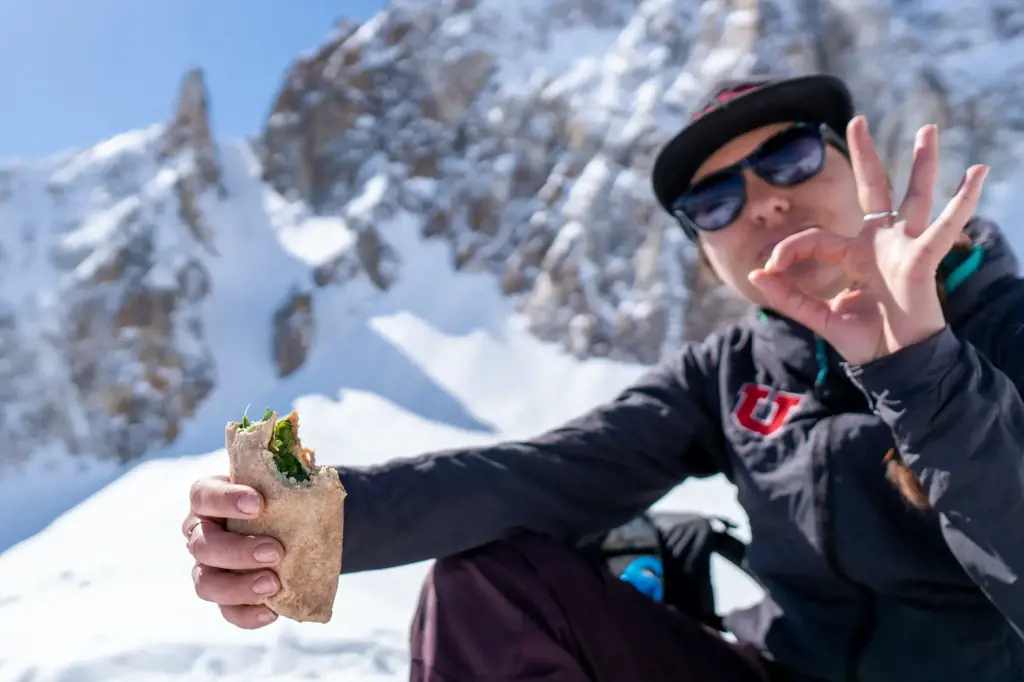
Backcountry skiing trips can be exhilarating experiences, allowing you to explore untouched snow-covered mountains and escape the crowds. However, when venturing into the backcountry, it is crucial to be prepared and pack the necessary food and water to sustain yourself throughout the trip. In this article, we will discuss how much food and water you should pack for a backcountry skiing adventure.
The amount of food and water you need to pack for a backcountry skiing trip will depend on several factors, including the duration of your trip, the intensity of your skiing activities, and individual needs. It is essential to consider these factors to calculate accurately the amount of sustenance required for your adventure.
Duration of Trip:
First and foremost, you need to determine the duration of your backcountry skiing trip. Are you planning a one-day excursion or a multi-day expedition? The length of the trip will directly impact the amount of food and water you need to pack. For longer trips, it is crucial to have enough provisions to sustain yourself throughout the journey.
Daily Caloric Needs:
Next, you must estimate your daily caloric needs. Backcountry skiing is a physically demanding activity that burns a significant number of calories. According to the National Outdoor Leadership School (NOLS), you should aim for around 3,000 to 4,000 calories per day in the backcountry to meet your energy requirements. This estimate can vary depending on your body weight, metabolism, and overall fitness level.
Nutritional Balance:
While it may be tempting to pack calorie-dense foods like granola bars and trail mix, it is important to maintain a balanced diet during your backcountry ski trip. A combination of carbohydrates, proteins, and healthy fats will provide sustained energy and aid in muscle recovery. Pack a variety of dehydrated meals, nuts, dried fruits, and high-protein snacks to ensure a well-rounded diet.
Water Requirements:
Proper hydration is essential for backcountry skiing. Cold temperatures and physical exertion can increase your body's water needs. As a general rule of thumb, plan to consume at least one liter of water for every two hours of skiing. Additionally, consider the availability of water sources along your route, as this will impact the amount of water you need to carry. In areas with accessible water sources, you can rely on water purification methods such as filters or purification tablets to ensure safe drinking water.
Planning for Contingencies:
When preparing for a backcountry skiing trip, it is important to plan for contingencies such as unexpected delays or emergencies. Pack a few extra days' worth of food and water in case you encounter challenges that extend your trip. It is always better to be over-prepared than underprepared when it comes to sustenance in the backcountry.
In conclusion, the amount of food and water you should pack for a backcountry skiing trip depends on the duration of your journey, daily caloric needs, nutritional balance, water requirements, and contingency planning. By considering these factors and packing accordingly, you can ensure a safe and enjoyable skiing experience in the backcountry. Remember to consult with experienced backcountry skiers or seek guidance from outdoor professionals to tailor your food and water requirements to your specific trip.
Essential Items to Pack for a Productive Work Conference
You may want to see also

Are there any additional items that are helpful to bring but not essential for backcountry skiing?
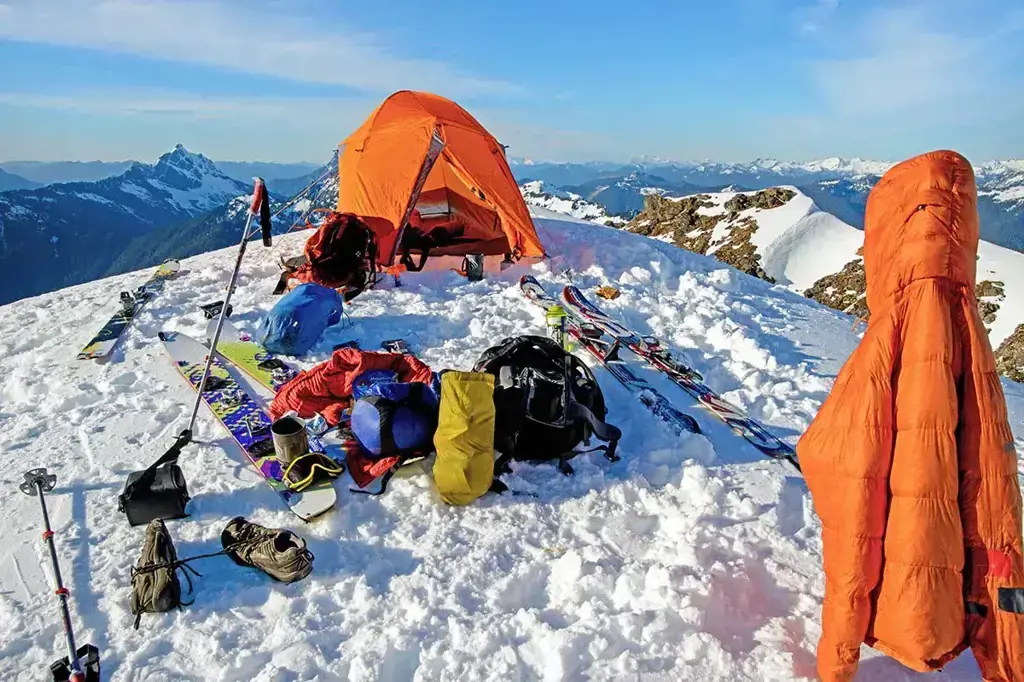
When heading out for a backcountry skiing adventure, there are a few essential items that you definitely don't want to leave behind. These include your skis, boots, poles, safety equipment such as an avalanche beacon, shovel, and probe, as well as appropriate clothing and a backpack to carry your gear. However, there are also a few additional items that can enhance your experience and make your day in the backcountry more enjoyable.
One helpful item to bring along is a pair of climbing skins. These are adhesive strips that you attach to the bottoms of your skis to provide traction when ascending steep slopes. Climbing skins can make the uphill climb much easier and more efficient, especially in icy or hard-packed snow conditions.
Another item that is helpful to have is a lightweight, collapsible ski pole. These poles are designed specifically for backcountry skiing and can be easily stashed in your backpack when not in use. They are a great tool for balance and stability while traversing or skiing downhill.
A small repair kit is also a good idea to have on hand. Backcountry skiing can be rough on your gear, and having the ability to fix any equipment issues on the go can save you from having to end your day early. A repair kit should include items such as duct tape, zip ties, and a multi-tool.
Bringing a lightweight, packable windbreaker or shell is also a smart choice. Even on warm days, the weather in the backcountry can change quickly, and having an extra layer to protect against wind and rain can make a big difference in your comfort levels.
Finally, consider bringing some snacks and water. Backcountry skiing is a physically demanding activity, and it's important to stay properly fueled and hydrated. Choose lightweight, high-energy snacks that are easy to eat while on the go, such as energy bars or trail mix.
In summary, while the essential items for backcountry skiing are fairly straightforward, there are a few additional items that can enhance your experience and make your day in the backcountry more enjoyable. These include climbing skins, lightweight collapsible ski poles, a repair kit, a windbreaker or shell, and snacks and water. By being prepared with these additional items, you'll be sure to have a great day in the backcountry.
Essential Items to Pack for Your Singapore Trip
You may want to see also
Frequently asked questions
When packing for backcountry skiing, it is important to bring the essential safety equipment. This includes a backpack with a shovel, probe, and avalanche beacon. You should also pack enough water and food for the day, as well as extra layers of clothing to accommodate changing weather conditions. It is also recommended to bring a first aid kit, sunscreen, a map or GPS device, and a multi-tool or pocket knife.
Yes, if you are planning on backcountry skiing, you will need to bring your own skis. Backcountry skis are designed specifically for off-piste or ungroomed terrain and have features that make them more versatile in variable snow conditions. It is important to have the appropriate gear for backcountry skiing, including skis with touring bindings and climbing skins, as well as ski boots that are compatible with the bindings.
Absolutely, avalanche safety gear is essential when backcountry skiing. This includes a backpack with a shovel, probe, and avalanche beacon. These tools are used in the event of an avalanche to locate and rescue buried skiers. It is also recommended to take an avalanche safety course to learn how to properly use this equipment and understand the principles of avalanche awareness. Additionally, it is important to regularly check avalanche conditions and carry a map or GPS device to navigate the backcountry.


